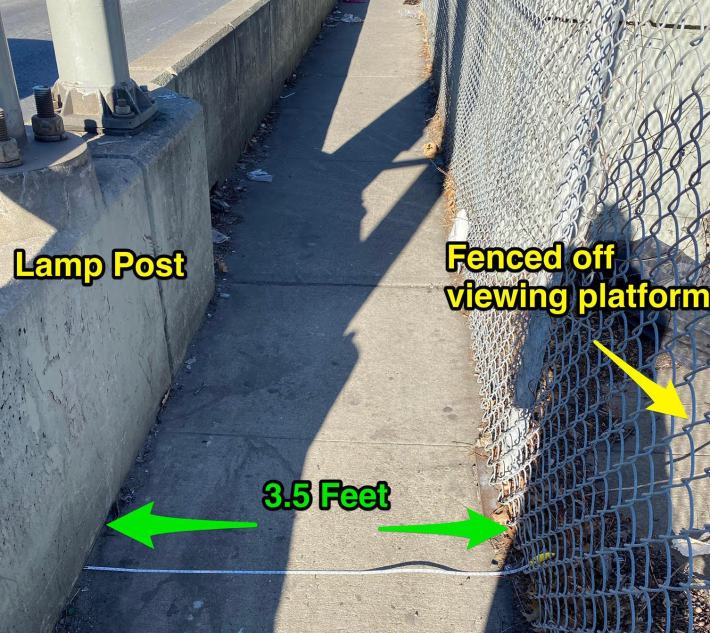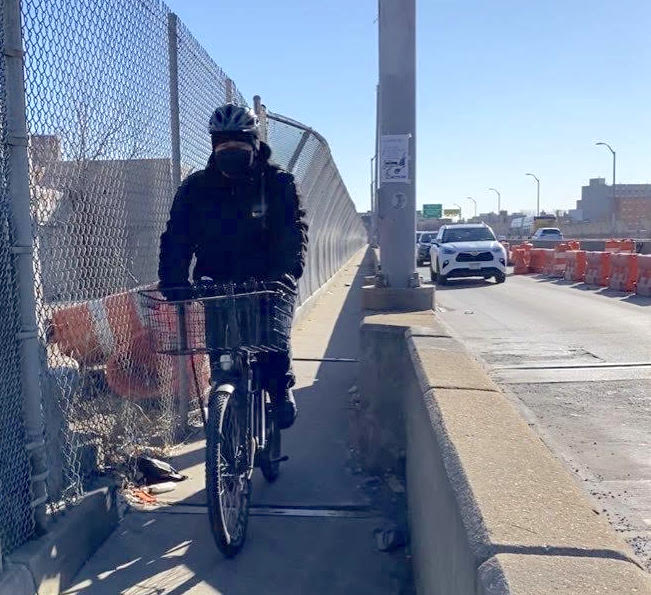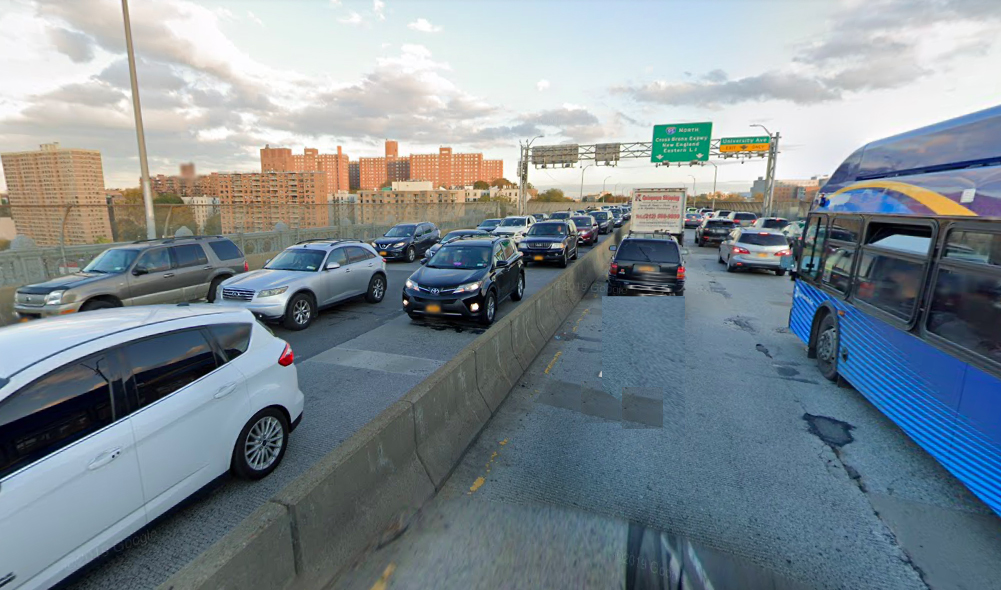Washington Bridge, not to be confused with the nearby George Washington Bridge, arches over the Harlem River at 181st Street, connecting the West Bronx to Washington Heights. Opened in 1888 as a pedestrian-only bridge, it was the second major bridge built in the city after the Brooklyn Bridge. By 1950, however, Robert Moses had reconfigured Washington Bridge to favor cars, gutting its sidewalks.
In 1982, the Landmarks Preservation Commission awarded landmark status to Washington Bridge, noting it was “considered one of the nation’s finest 19th-century steel arch bridges.”
Travelers crossing the dilapidated bridge today would find the designation hard to believe.
The bridge accommodates six car lanes and two narrow pedestrian paths on either side — which are only 4.5 feet at their widest and 3.5 feet at pinch points. It’s common practice to shimmy past other people. Inwardly curved security fencing installed inside the original guardrail further reduces clearance and obstructs views of the Harlem River. The paths' entrances are unmarked; the sidewalks are crumbling, and curb ramps are blocked by parked cars. Adjacent intersections are dangerous for all users. Buses crawl across, competing with cars and trucks. The bridge inadequately supports anyone except drivers.
As many know, residents of the Bronx and Upper Manhattan must wait at the end of the line for transit and infrastructure improvements. Mayor de Blasio recently heeded Transportation Alternatives's Bridges for People campaign and committed to repurposing car lanes for bike lanes on the Brooklyn and Queensboro Bridges. Proposed transit, bike, and pedestrian improvements to Washington Bridge, however, languish in limbo.
We call upon de Blasio and the candidates running for mayor this year to prioritize much-needed fixes to Washington Bridge, including adding a two-way bike lane, improving pedestrian-path accessibility, heightening the safety of adjacent intersections, and establishing dedicated bus lanes.

Why is this bridge so important? For starters, Washington Bridge is the only 24/7 accessible Harlem River crossing for pedestrians and cyclists between the Bronx and Manhattan for miles. The bridge feeds to Washington Heights's 181st Street corridor, home to a central transit hub, vibrant small businesses and restaurants, and access to the greenways skirting Manhattan. Heading into the Bronx, the bridge connects bus routes leading to vital public-health and educational institutions, and greenways to state and city parks. Medical and restaurant essential workers are among those who traverse the bridge in high numbers daily.

For the most part, local residents are not the ones driving across Washington Bridge. According to Bronx Community Board 5’s District Needs Statement, nearly 89 percent of residents in the West Bronx do not drive. The Department of Transportation reports that 69 percent of Upper Manhattan residents (those in CB12) don’t own cars, and that 89 percent of consumers visiting businesses on 181st Street arrive by bus or subway, walking, or biking.
Given the low local car ownership, we might ask: Who are the car lanes on the Washington Bridge serving? Hint: The bridge serves as a popular detour for drivers over a congested portion of the Cross Bronx Expressway.
Washington Bridge must be reconfigured to better serve the people of the Bronx and Upper Manhattan. Because the bridge serves as a major choke point for five bus routes with 36,800 weekday riders, the DOT recommended installing a dedicated bus lane in both directions. It also recommended a Busway pilot for the 181st Street corridor — which has overwhelming local support. These dedicated bus treatments could raise bus speeds by up to 20 percent and improve reliability for all area bus routes, including school buses. Rolling out the Washington Bridge bus lanes, together with surrounding busway treatments, would be optimal.
As for the claustrophobic bike and pedestrian paths, the DOT’s 2018 "Connecting Communities" report recommended adding a two-way bike lane and improving overall accessibility — although the agency hasn’t offered a timeline.
Hundreds of people use these paths daily, navigating dangerous and unwelcoming conditions. With Citi Bike quickly expanding uptown and scooters gaining in popularity, more crowding will occur. It’s absurd to force all these mixed modalities to share a 3.5 foot path. The Bronx and Upper Manhattan deserve better.
In January, the DOT commenced a $20 million construction contract to bring the bridge’s roadway to a state of good repair. The paths and car-lane configuration, however, will remain untouched. Why not use this opportunity to implement some of the bike, pedestrian, and transit changes DOT already recommended? This huge missed opportunity is an example of privileged car drivers coming before New Yorkers who do not have access to a private vehicle.
As Transportation Alternatives detailed in its new NYC 25x25 report, streets that prioritize people over the movement and storage of private cars will improve our health, environment, and quality of life — and are good for businesses, too. These improvements also will begin to reverse the longtime disinvestment from heavily lower-income, immigrant, and Black and Latinx uptown communities.
We urge residents to show their support by signing the #WashingtonBridge4People Petition; we urge our leaders to restore Washington Bridge to its former glory as a people-centered crossing between Upper Manhattan and the Bronx.
Lucia Deng (@luciadlite) is a member of Transportation Alternatives Bronx Activist Committee member and resident of the West Bronx.







